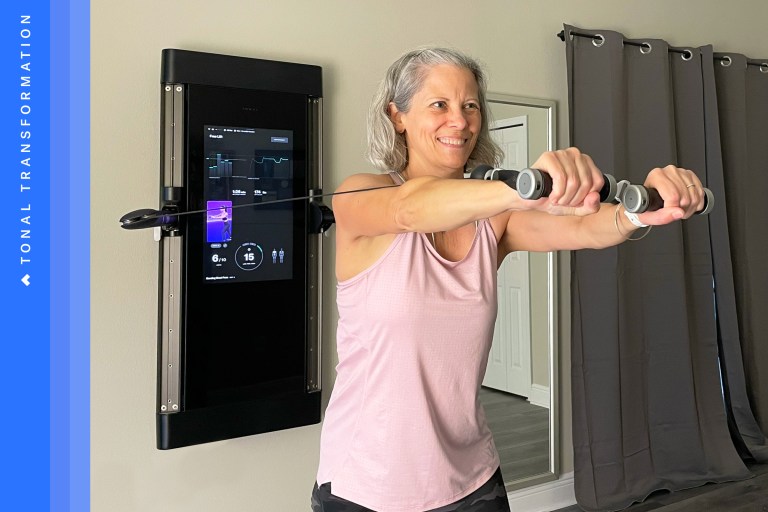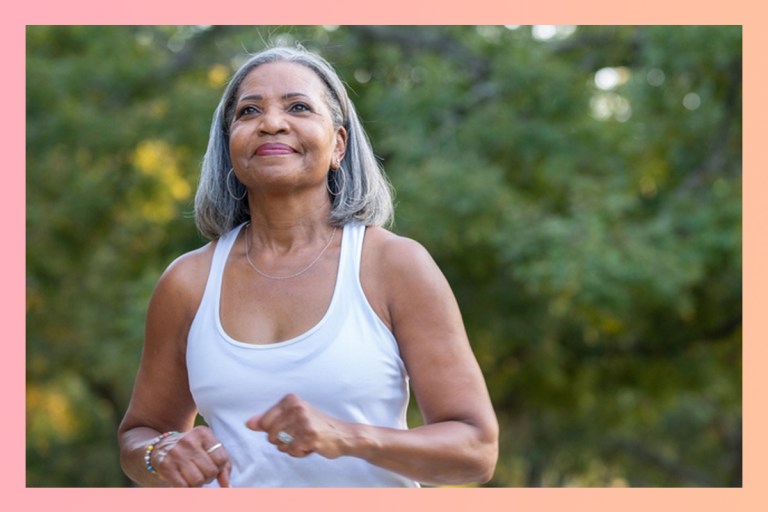Building Muscle After 40 Is Hard But Not Impossible. Here’s How.
How resistance training can help you feel better, stronger, and more confident as you age.

After turning 40 this year, Tanysha Renee, a certified personal trainer and Tonal coach, started seeing subtle changes in her body. “Weight stays on longer, [I noticed] changes in my skin, and my cycle has shifted,” she says. Even though she always brings the energy when she’s coaching, Renee started to feel less motivated to do overly strenuous workouts.
This motivated her to research how the body responds to exercise as we get older and led her to pay even more attention to building muscle the right way. “We’re all going to experience sarcopenia, which is the loss of muscle,” she says. “But you can slow it down and also look, feel, and move better [through] working out and strength training.”
Whether you’re starting resistance training in your 40s or building on a routine you’ve had for decades, you might notice some changes in how your body responds to exercise. But by training smarter and supporting your workouts through a healthy lifestyle, you’ll see that building muscle after 40, and even beyond, is absolutely possible.
Why Building Muscle after 40 Is More Challenging—But So Important
By the time you hit 40, your body is already starting to experience sarcopenia. In fact, research shows that muscle mass decreases approximately 3 to 8 percent per decade after age 30.
Most biological processes, including wound repair, tissue regeneration, and muscle building, begin to slow down as we age, according to Stuart Phillips, PhD, a professor of kinesiology and director of the Physical Activity Centre of Excellence at McMaster University. While some of this change is inevitable, your lifestyle also influences how quickly muscle breaks down. A sedentary lifestyle is one of the biggest contributors to muscle loss, says Phillips. “The old idiom of ‘use it or lose it’ really applies.”
Shifting hormones also makes building muscle after 40 more difficult. While men start experiencing a gradual decline in muscle-building testosterone in their 30s, this hormonal change is more abrupt for women once they hit menopause. “We have this discernible point where, boom, all of a sudden things change on a dime,” says female physiology expert and Tonal Advisory Board member Stacy Sims, PhD. Because estrogen and progesterone drive lean muscle mass development in women, the dramatic drop in these hormones makes it harder to build strength.

Lifestyle factors in your 40s play a role, too, as Troy Taylor, Senior Director of Performance at Tonal explains. “People get busier, they have kids, they’ve got busy jobs, and they don’t work out as much,” he says. Adults ages 18 to 34 hold the largest percentage of U.S. gym memberships, according to a 2021 report by the International Health, Racquet & Sportsclub Association, indicating the drop-off that comes with age.
Losing muscle doesn’t just affect how you look. It’s also associated with a significantly higher risk of death due to falls, fractures, and other causes, according to a 2022 meta-analysis. But building muscle after 40 is possible, and putting in the work can have additional benefits. Research shows that strength training can improve cognition and joint health, and help maintain bone density.
5 Tips for Building Muscle after 40
No matter how old you are, you can still build muscle and improve your health through resistance training. One systematic review of studies found that you can even gain strength into your 70s and 80s.
“The sooner you start, the easier it’ll be to maintain and build that muscle,” says Renee. “If you’re starting your fitness journey after 40, be patient with the process.” Here are five tips for keeping the gains coming as you age:
1. Train Smart
The fundamentals of building muscle after 40 aren’t that different than they are when you’re in your 20s, according to Renee, although it’s important to train smarter—not harder—to ensure you’re able to keep going.
“Older people have higher levels of oxidative stress,” says Taylor, which is an imbalance in the body between free radicals that can cause cellular damage and the antioxidants that reduce their impact. One outcome of oxidative stress is inflammation which makes it more difficult for your body to recover in between workouts, so you might have to reduce training volume and frequency as you get older.
Fortunately, you don’t have to train every single day at max intensity to see gains. A systematic review and meta-analysis looking at strength training results in adults with an average age of 65 found that the most effective routine involved lifting three sessions per week, two to three sets per exercise, seven to nine reps per set, and at an intensity between 51 and 69 percent of your one-rep max.

On Tonal, try a workout in the Ageless Strength series designed specifically for older adults: Ease into Action, Fit and Functional, and Dynamic Muscle. These sessions are geared toward gaining strength for movements you do in everyday life and improving coordination, balance, and stability.
Overall, you’ll get the best results by sticking with a regular lifting routine and avoiding injuries that’ll halt your training. “Adhere and persist and ‘magic’ will happen,” says Phillips. “Consistency wins the game.”
2. Embrace Modifications
Part of training smarter involves choosing exercise modifications that feel better on your body. “As we get older, we start to get more aches and pains,” says Taylor. Your individual needs might require you to modify specific exercises, for example, opting to do pushups with your hands on the bench instead of on the ground if your wrists hurt or choose to focus on improving one area, such as building strength around the knee to reduce joint pain.
When you’re training on Tonal, you always have the option to skip a move or swap in a movement replacement that works better for you. Modifying doesn’t mean that you’re shortchanging yourself in your workout, but rather that you’re making a smart choice that’ll enable you to keep moving without risking injury. As Jenna Moore, a certified strength and conditioning coach and Programming Specialist at Tonal, says “Modifications are a sign of wisdom, not weakness.”
3. Prime For Power
Everyday movements such as climbing stairs and crossing the street before the light changes are reliant on your ability to generate power, according to Phillips. Power training, or moving resistance with speed, helps maintain fast-twitch muscle fibers that tend to slow with age so you can move with more agility and coordination.
Sims says this type of training is especially important for women looking to preserve their athletic edge after menopause. She recommends high-intensity sprint-interval training (consisting of intervals of 30 seconds or less at your maximum capacity) over longer bouts of low-intensity training, explaining that women naturally have the capability to perform well at steady-state cardio like long runs or bike rides, but need an extra boost to increase power.
4. Dial in Your Nutrition
Along with resistance training, you’ll want to make sure you’re optimizing your nutrition, especially protein intake, to promote muscle growth. Protein helps with building muscle and repairing tissue after workouts.
“We get less efficient at protein synthesis as we get older, so we want to [eat] on the upper end of the recommended guidelines,” says Taylor. While the recommended dietary allowance (RDA) for protein is 0.8 to 1 gram per kilogram of body weight per day, research suggests that older adults should be eating around 1.6 grams of protein per kilogram of body weight to support muscle growth. For example, a 150-pound woman should be eating roughly 109 grams of protein per day.
Renee recommends starting by tracking your daily protein intake to see if you’re hitting your numbers or need to work on taking in more protein. Aim to spread out healthy sources of protein, such as lean animal protein, eggs, nuts, tofu, and beans, throughout the day.
5. Focus on Recovery
Adequate recovery in between your workouts is essential no matter your age, as it’s during this repairing and rebuilding period that your muscles actually grow. “If you are not recovering well, your muscles don’t have the bandwidth to take on additional growth because they’re already so overused,” says Renee.
As you get older, recovery becomes even more of a priority since you might not bounce back as quickly between workouts. Make time in your routine for active recovery sessions and deload training to restore range of motion and boost circulation to sore muscles after hard efforts.
Even though it’s always smart to get plenty of sleep, Taylor points out that this becomes even more important as you get older. “We can generally operate a little better with [less] sleep when we’re younger than we can when we’re older,” says Taylor. For optimal muscle growth, aim for seven to nine hours of sleep. Good sleep hygiene, such as keeping your bedroom cool and dark, avoiding caffeine in the afternoon, and limiting exposure to blue light at bedtime, will help you get there.
The information provided in this article is for educational and informational purposes only. Individuals with pre-existing health conditions, injuries, or concerns should consult with their healthcare provider before trying a new exercise or nutrition regimen.



